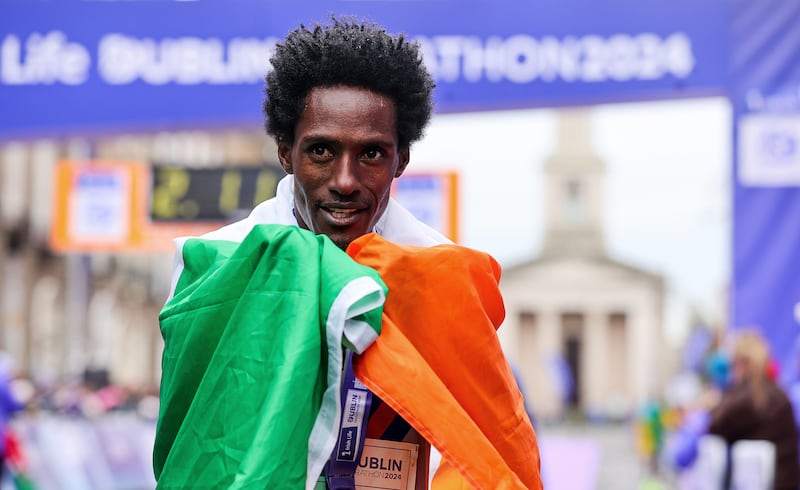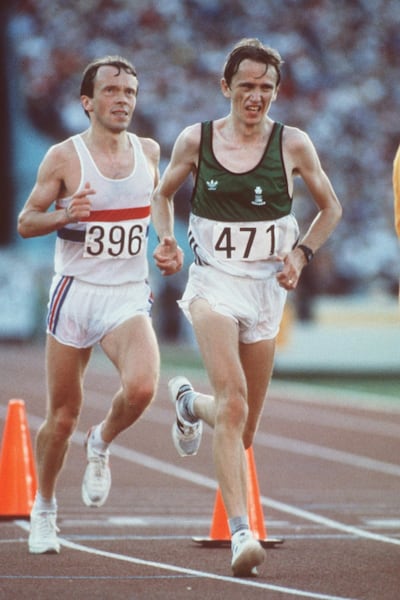Before the rain came and the autumn breeze whipped up, conditions at the start and finish of the Dublin Marathon last Sunday morning were ideal. No reason to hang around then. In the end, few runners found greater reward, after a brave and beautifully balanced effort over the 26.2 miles, than Hiko Tonosa.
He crossed the finish line on Mount Street in third place overall, clocking 2:09:42. In my 30-odd years of reporting on the Dublin Marathon, any Irish runner who makes the overall podium was greeted with special acclaim, but Tonosa’s celebration was something more. He sought asylum in Ireland from his war-torn village in Ethiopia back in 2017, before gaining Irish citizenship in 2020.
After briefly falling flat on his back at the finish, a tricolour draped over his shoulders, the 29-year-old running for Dundrum South Dublin leapt up and started sprinting back down the finishing straight towards the Pepper Canister Church, moving like loose electricity, mainlining the last of his race adrenaline, as well he might.
His effort had been complete. After passing halfway in 64:13, Tonosa’s finishing time was promptly announced as a new Irish marathon record, eclipsing by seven seconds the 2:09:49 which Stephen Scullion ran in London in 2020. Scullion had also finished on the overall podium in Dublin twice before, his 2:11:51 last year was, at the time, the fastest marathon ever run by an Irishman in this country.
The unknowns around Sunday’s inaugural running of the Dublin City Half Marathon
Jakob Ingebrigtsen’s father forced daughter to keep running, court hears
‘He hit me in the face’: The sister of Jakob Ingebrigtsen was struck by father as a child, court told
Kellie Harrington remains on €40,000 podium funding as some Sport Ireland investment figures yet to be realised
Tonosa’s previous best of 2:15:01 was run in Valencia back in January – a time he smashed here by the best part of six minutes – but he’s always shown the potential to run this sort of time, passing the halfway mark in London last April in 63:39, before dropping off that pace.
However, also sitting on that Irish marathon all-time list, albeit with a small asterisk, is the 2:09:15 which John Treacy ran to finish third in the Boston Marathon back in 1988. Holding these times up to a little more scrutiny is not unjustified.

Up to 2003, World Athletics didn’t actually recognise any world records set on the road, given the variety of elevation and terrain, listing them instead as “world bests”. Then after agreeing a set of record-criteria in 2004, world records could be set on the road, similar to the track and field, and likewise national records too.
For the marathon, there were two key conditions for record-setting purposes. The decrease in elevation between the start and the finish could not exceed an average of 1m per km; and the start and finish points, measured along a theoretical straight line between them, could not exceed 50 per cent of the marathon distance.
Incidentally, this rules out the original marathon course from 490BC, from the town of Marathon down to Athens, for any record purposes, although having once just about completed that course myself, a somehow easier or faster course it most definitely is not.
The first recognised marathon world best was the 2:55.18 set by the Irish American Johnny Hayes at the 1908 Olympics in London, and although Boston is the longest-running city marathon in the world, starting in 1897 and inspired by the Athens Olympics the year before, it has only once produced a world best, legal or otherwise, when Geoffrey Mutai from Kenya ran 2:03:02 in 2011.
The problem with Boston for record purposes is that it averages a decrease in elevation of 3.23m per km, and the distance between the start and finish point is 91 per cent of the race distance. On that basis, Mutai’s time wasn’t even submitted to World Athletics for consideration.

So to Treacy’s 2:09:15 run in Boston in 1988, which at the time was only the second marathon that he finished. After winning his Olympic silver medal in LA in 1984, running the Irish marathon record of 2:09:56, Treacy became hot property in marathon running, yet was reluctant to make a permanent move to the distance, or at least to surrender his career on the track.
When Treacy’s next marathon after LA did come calling, in 1987, he was always sure it would be Boston, and now flush with sponsorship money from John Hancock Financial Services, an all-star field was assembled, including the Australian Rob de Castella, winner the previous year in a course record of 2:07:51, plus Japan’s Toshihiko Seko, the Boston champion from 1981.
Boston does unquestionably benefit from some nice rolling hills at the start in Hopkinton, but it’s also much feared for Heartbreak Hill, which comes around mile 20, the same time as the infamous Wall. What Treacy discovered was Heartbreak Hill hurts as much coming down as it does going up, the breaking leg action soon crippling his quad muscles. By mile 21 he was reduced to a near crawl. It took two hours to be driven through the crowds back to the finish.
A year later, in 1988, Treacy only decided to run Boston again on short notice – four days before, to be exact – confident he was hitting a sort of marathon-running peak. And so it proved, as Treacy broke everyone on the downhill and uphill except for the African duo of Ibrahim Hussein and Juma Ikangaa, Hussein taking the win in 2:08:43, Treacy holding on for third in that 2:09:15.
It is worth remembering, too, that this was long before the era of super shoes, and while Treacy was wearing a pair of custom-made New Balance racing flats, there was minimal cushioning and not an ounce of carbon. If you saw those shoes now, they’d be considered anti-super.
He ran Boston again the following year, under even greater fanfare, and after another hard-fought race had to settle for third once again, running 2:10:24.
When Treacy lined up in Boston for the fourth and final time, in 1991, all the lessons of the past were neatly executed: he held back early on, gently rolled over Heartbreak Hill, looked primed for another podium finish, before the short, sharp downhills – part of what rules Boston out for record purposes – once again proved his undoing, as he sat on the kerb outside Boston College, at mile 21, clutching his right hamstring with one hand, and covering his face with the other.
Which is also why in some people’s eyes his 2:09:15 may not be the official Irish marathon record, but is still quite possibly the greatest Irish marathon ever run. At least until Hiko Tonosa starts looking towards that 2:09 barrier and thinking: “Why not now?”

















